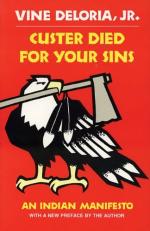
|
| Name: _________________________ | Period: ___________________ |
This test consists of 5 multiple choice questions, 5 short answer questions, and 10 short essay questions.
Multiple Choice Questions
1. What kind of people do anthropologists believe the Indians are?
(a) A folk people.
(b) A foreign people.
(c) A native people.
(d) A white people.
2. Like the missionaries, what have anthropologists become intolerably certain of?
(a) That they need more time with Indians.
(b) That they need more study of American Indians.
(c) That they know the ultimate truth.
(d) That they know very little about Indians.
3. What are the two mainstream American Indian organizations?
(a) The National War Survivors of America.
(b) The National Congress of American Indians and the National Indian Youth Council.
(c) The National Land Rights Owners.
(d) The National Water Rights of Indian Reservations.
4. Why did the Klamath Bill have to be amended?
(a) To prevent them from living in a national park.
(b) To prevent collapse of the lumber industry on the west coast.
(c) To prevent tourists from overrunning their fishing areas.
(d) To prevent the extinction of salmon.
5. What is the best way for tribes to handle their reservation conflicts?
(a) With government intervention.
(b) With outside help.
(c) With new rules established by white men.
(d) In traditional Indian fashion.
Short Answer Questions
1. What happened to the oldest treaty between the U.S. and the Seneca tribe?
2. What does not overlap across state boundaries?
3. What did treaties initially do?
4. What does the author believe anthropologists should do in the future?
5. Which group of Indians did Arthur Watkins target first in his work for the government?
Short Essay Questions
1. Describe the treatment of the Choctaws. Why was their treatment worse when compared to other Indian peoples?
2. How did William Zimmerman, Acting Commissioner of Indian Affairs classify existing tribes into categories for Termination?
3. What is the history of the Sioux who lived along the Missouri River?
4. What did anthropologists find about alcoholism on the reservation? What does the author think of this finding?
5. What are the Five Civilized Tribes and why are they referred to in this way?
6. What is the Treaty of August 5, 1826 with the Chippewa tribe known for?
7. What criteria, according to the author, do whites use to say that they "understand" Indians?
8. What was Frank Church's attitude towards the Indian? Why was this line of thought so harmful during the time of Termination?
9. What are the 4 main rules to Rene Descartes' method of research? Was this a good method to examine the lives of Indians for Termination?
10. What is the problem with most books about American Indians, according to the author? What do the incorrect portrayals of the Indians do to harm the image of the Indian, and complicate understanding of the people by others?
|
This section contains 1,324 words (approx. 5 pages at 300 words per page) |

|




